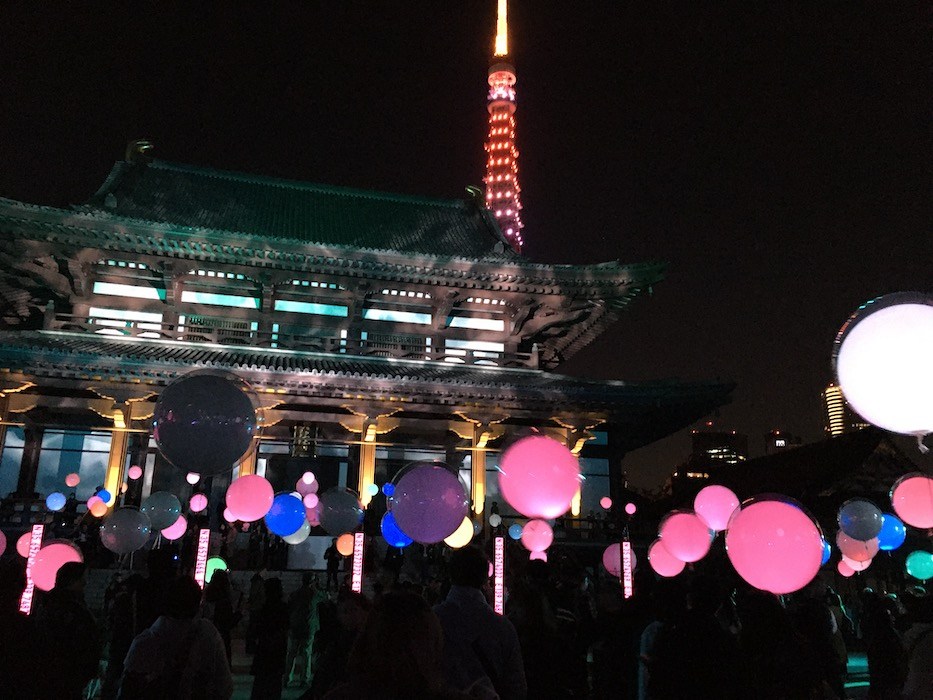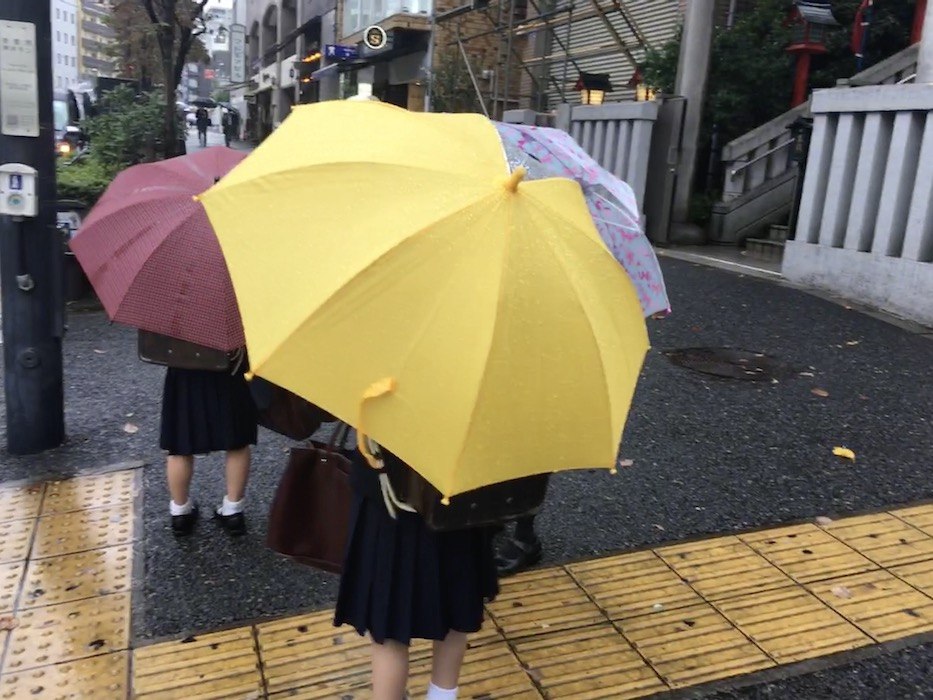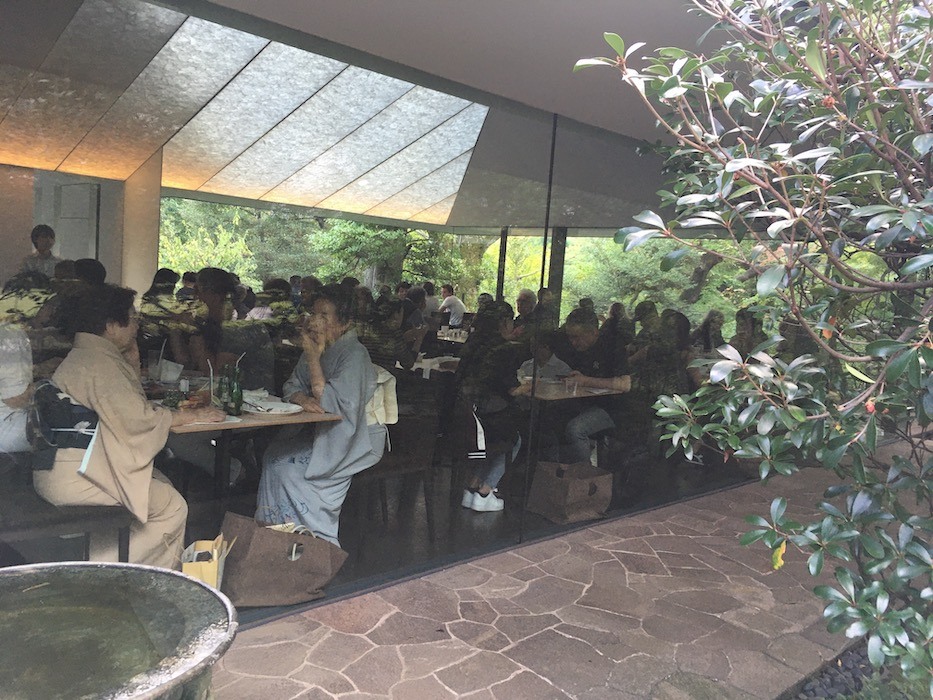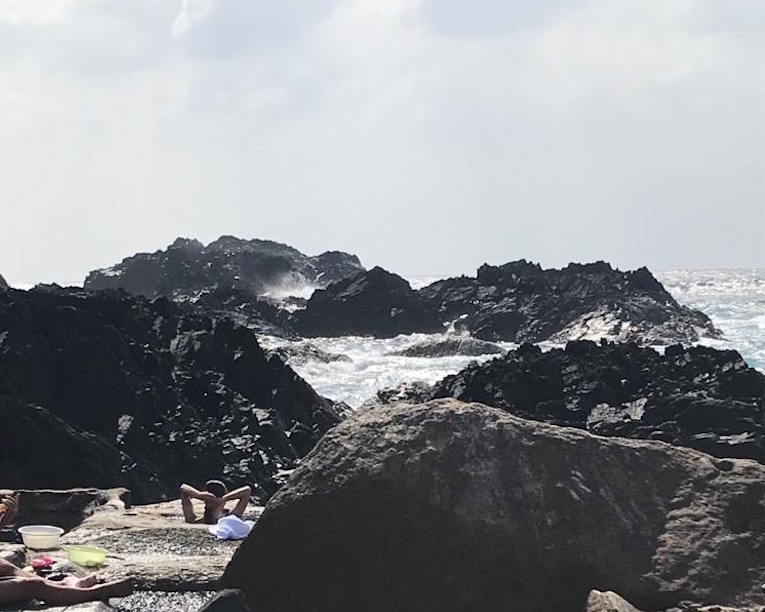When friends ask me about Tokyo, my answer takes them by surprise: I walked, mostly. I visited sites and had culinary experiences. I bathed in hot springs in the mountains of Nagano, where wild monkeys do the same. I stood close to a monk sounding the six o’clock bell by the five-story pagoda in the ancient city of Nara. But what I treasure most when I think of the four months I spent in Japan last fall are those endless and aimless walks I took Monday through Friday surrounded by Tokyo’s women.
I arrive on a rainy Saturday to a studio apartment in Azabu-juban, a bland expat neighborhood, to be with my partner, an English journalist on assignment. “This is a huge box here,” he says, giving me the tour of the small room. We both laugh. “And there’s a lovely temple right behind us. Their chanting services are quite beautiful.” But I’m not really a temple-goer or the class-taking type. I am in a place I know nothing about and without a project to keep me occupied. But that’s fine because the one thing I know for sure is that while here I am not interested in going around with my journalist antennae switched on, which is how I usually travel. I want to give them a rest.
Under the fog of jet lag, I absorb Tokyo that weekend, taking the first of the many walks I will come to take. A visit to the tatami-matted mansion of a former grand lord and to the garden of a bonsai master offer glimpses of a pre–World War II Japan ruled by an Emperor. I slurp soba noodles with walnut sauce in a trendy restaurant and walk through impeccably clean canal-lined streets, ducking in and out of the perfectly curated clothing shops of a more modern, fashion-fabulous Tokyo.
Four days after my arrival, still jet-lagged, I switch on the TV and learn that I’m here at a historic moment. Prince Naruhito, the firstborn son of Emperor Akihito, is ascending the Chrysanthemum Throne. Groggy, I watch monks in black robes pull back the purple curtains of a huge gilded birdcage to reveal the handsome emperor-to-be, soon to be sixty, wearing an ochre robe and brandishing a saber like Luke Skywalker’s, a strangely pitched black hat fastened beneath his chin with a white rubber band. He looks somewhat ridiculous, yet carries it all with incredible aplomb. Next to him, on an identical stage and in an identical cage, his wife of twenty-seven years appears less comfortable. Princess Masako, a Harvard-educated lady who gave up a promising career as a diplomat to assume her role as prince’s wife and Empress-to-be, wears a twelve-layered kimono, the most formal court garment, that is as beautiful as it must be heavy. She seems to be swallowed by sheaths of brightly colored silk.
Among the notables in the crowd, I recognize Prince Charles, the king and queen of Spain, and a roomful of other famous faces. They sit shoulder to shoulder like they haven’t done since the pandemic started: Fifteen kings, seven queens, four princesses, eleven princes, seventy presidents, and a hundred other dignitaries have come for the weekend ceremony, and they all wear the most extravagant jewels and flowered hairpieces, orders and medals pinned on uniforms, turbans, saris, and caftans. When I hear that the president of Panama and the foreign minister of Colombia are in attendance, too, I wonder why they’ve come all this way: it is because Japan is the world’s third-largest economy? Or because this island’s ancient rituals are so rarefied that no one wants to miss the opportunity?

“Coded Field,” an art installation at Zozo-ji Temple in November 2019. Photo copyright © Silvana Paternostro.
I am immediately enchanted by the otherworldly fantasia of the world’s oldest monarchy. My ears perk up when the commentator’s mention a pregnant princess in attendance that gave up her title to marry a commoner. Who doesn’t love a rebel princess? I decide to follow the upcoming enthronement events of which there are a few remaining and wonder what it would be like to go from princess to average woman, like the ladies I start to notice on the streets every day as I begin my life as a flaneur in Tokyo.
***
It takes me a while to become a confident walker. I don’t understand the signs and it’s hard to ask for directions when you can’t communicate. As soon as I accept I will have to navigate a world of unknowns, I let go of trying to fit in. Feeling like a complete klutz, I confess, is quite liberating. Every day that I step out I feel disarticulated from the first interaction to the last, even if I do follow the outward form of practices: enter a temple (wash hands before clapping at the altar), going to a kabuki theater (bring bento box with food for intermission), visit clothes store (try on dresses with a facial covering on and this is pre-Covid 19); bathe at a hot spring (never dunk completely).
Before I begin my meandering walk, I flip through the Japan Times. Reading local papers is a hard-to-break reporting habit. But it’s also a way to keep up with the prince who will become emperor.
Next ceremony on the agenda: On November 14, Prince Naruhito will enter a huge white compound outside the Imperial Palace bearing the best of Japan’s rice (each grain is perfectly polished before its boiled), fish, and sake to offer to the mythical goddess believed to have been the creator of ancient Japan in the seventh century BC and the prince’s direct ancestor. Figuratively speaking, the prince will lay with Amaterasu’s spirit overnight, wearing an almost bridal-white robe asking for advice. Amaterasu, I learn, was not only goddess. She was also Empress.
***
My routine for each walk is quite simple. I choose a destination and walk to it without any hurry. On this day, I am going to the Meiji Shrine. According to Google Maps, it’s about three miles away. I first buy a coffee at the Natural Lawson convenience store under the Tokyo Tower, Japan’s white and orange Eiffel Tower look-alike and smile at the young cashier with pigtails—she reminds me of an unhappy girl working at a convenience store from a short story I once read. In the backstreets, I smile again at the elderly lady in her dirty apron I see every day selling daikon, cabbage, and clementines as if she were living in the countryside and not in a sophisticated urban neighborhood. She reminds me of the Cuban ladies who tend similarly simple vegetable stands outside some of the mansions crumbling down in Havana. I walk up the street past Olive’s Café. Olive is at least ninety and her café is probably the only coffee shop without Internet in all of Japan, but what her dingy establishment lacks in modernity she makes up for with her bright smile and pep.
In a matter of a few steps, I go from scenes out of prewar Japan to tableaus of the more homogenized globalization. I pass an English bakery offering pie-baking lessons, a Pilates studio, a shop that sells bagels and vegan matcha lattes, and a bauble shop where a handful of coiffed women sit around a table, immobile and downcast, like figures from Pompeii: maybe they’re at work painting porcelain, or beading necklaces, or any one of those time-passing activities I’ve always associated with women who lead traditional family lives. The reporter in me would have loved to talk to them.
It’s starting to drizzle as I wait for the pedestrian light to turn green at the corner of the Azabu metro station, next to the shrine that has a huge frog-spirit statue outside. I notice a trio of very young schoolgirls, around six or seven, wearing plaid skirts, square backpacks, and trilbies. Picture perfect—I point my phone at them. I realize they are on their own, and they realize I am taking a photo. They give me a stare of total disapproval and swiftly cover their faces with their umbrellas. Turning their backs on me, they scurry down the stairs inside the station. I’ve never seen such young girls this on it: so fierce, so graceful—and so independent.

A group of schoolgirls freely roaming the Tokyo streets near the Azabu metro station. Photo copyright © Silvana Paternostro.
Whizzing by me are women on electric bikes packed with parcels and often a pair of children. I wonder if the princess turned commoner pedals around in one of these mama-charis as they are called.
As it turns out, the princess is not such a rebel. All Japanese princesses become commoners if they decide to marry. This is a Catch-22 situation still in place from when the US rewrote the country’s constitution following World War II. In an effort to take away the aristocracy’s control of the country, all princely families lost their titles and princesses could only keep their title if they marry a prince. But as there are no princes left in Japan, other than their immediate family, more than a dozen ladies have suffered the downgrade. There are now five single princesses, including Princess Toshi, Naruhito’s daughter, facing demotion. She will still be invited to imperial events but only as a guest, and she will never appear in any official family photos with her father, the Emperor. I start to ponder about the plight of the princesses but my thoughts are like the fleeting lady bikers—they come and then pass as I let them go.
***
It rains a lot in Tokyo, so when the mornings are warm and sunny, I take a Japanese author to read—right now I’m binging on Yukio Mishima—and sit in a nearby playground. I watch mothers run after their youngsters: when they fall; when they push each other and it turns into a messy fight; when they do a cartwheel or something extraordinary for the first time— they, of course, act the exact same way children do everywhere. I notice there are much fewer fathers than at New York City playgrounds. They are laboring away; they are the so-called salarymen that my boyfriend complains he has become when he returns from work every evening, or after salarymen outings to an izakaya bar with his colleagues. I join them sometimes, but I am the only partner invited. I think I can come because I am gaijin—not Japanese.
The gender gap in the labor force is so big that Prime Minister Shinzo Abe came up with an attractive package known as “womenomics” as a way to bring women into Japan’s shrinking labor force. But there are so many women on the streets during working hours that all I can conclude is that women still do most of the childrearing and the cooking. I read that a young woman was harassed at a supermarket by an elderly man for buying ready-made potato salad. Women, he yelled, need to make it from scratch.
As everywhere else, the elderly generation would like things to remain as they are. This includes the tradition that husbands bring their widowed mothers to live with them. What is that like for the wives, the daughter-in-laws of the household, I wonder. I ask Marilyn, the first Japanese wife I meet, a thirty-something publicist for international brands in Japan. Except she is as nontraditional as they come. When my boyfriend and I meet her for a sushi extravaganza—her husband, a Norwegian artist, is a friend of a friend—she is an hour late. She cuts quite a figure with her fashionable clothes and red lipstick. Something about her is more New York than Tokyo—until she starts ordering the food and eating it, as only someone who grew up here knows how to do.
After all my long mute walks moving around a sea of anonymous women, it is a treat to finally speak to a woman in complete sentences and to hear her perspective on everything – from flea-market shopping (the best ones are in Kyoto) to parenting. Her husband’s artist schedule is much more flexible than hers, so he is the one who drops off and picks him up their son from elementary school; the one who shows up whenever parental presence is required. Because of this, the Japanese husbands like to refer to him—only half-jokingly—as “the enemy.”
The sushi keeps coming and Marilyn continues to reject the traditional cultural matrix. When we mention that we spend most weekends soaking in thermal springs, and that Japan really has amongst the best, she scoffs. “Not for me,” she says. Watching women groom in public makes her cringe. This makes me like her more. She really takes the nontraditional boat.
***
A month into my arrival, I decide it’s time to experience Shibuya Crossing, the world’s busiest pedestrian scramble. I plan to get there by bus and get lost looking for the stop. I see two boys and a girl in their early teens skip by and I ask for directions. Their faces light up. They are enjoying using their school-taught English so much that they walk with me all the way there. They tell me how much they like roaming the streets, stopping for bubble tea before they go home for study time. I ask if they are good students, and both boys gesture to the girl and say, “She is the best in the class.”
They take me through narrow back alleyways and I wonder if they would get into trouble if their parents were to find out they are talking to a stranger they met on the street. Isn’t that a universal no-no? When we get to the stop, they ask me to take their picture, and make peace signs with their hands.
I ride next to a schoolgirl with long hair carrying an enormous white origami lily in her hand and wonder if Tokyo is as safe as it feels. When I ask Marilyn, she tells me that her son is never allowed to get on public transportation alone.
Touristy Shibuya is where the kawaii generation promenades. There are so many girlie concoctions: it’s a sea of chunky platform shoes, lacy ankle socks, mini-skirts, more pigtails, plaid everything, topped with glitter everywhere as they enter the dollar stores and the nail salons. At Tokyo Hands, a popular department store, I see two girls dressed in identically tight nurse outfits trying on identical wigs. In Harajuku, the trendy fashion district nearby, I follow a gaggle of girls, about the same age as the Emperor’s only daughter, into a vintage shop and watch their faces light up at the sight of American granny housedresses from the fifties. I see one of them pay for a pale yellow unfitted sack, a most unsexy garment, with such delight that I understand it as a complete act of freedom. Whenever I see photos of Princess Toshi and her unmarried female cousins—I found a fan site to follow—I wonder if they choose their own clothing. They seem to prefer pearl necklaces and traditional suits.
Later that week, I sit for lunch at the Nezu Museum, a mansion with a small private collection and a glass restaurant overlooking its perfect garden. I’m surrounded by ladies who dress more like the imperial family, some are wearing impeccable kimonos. I wonder when and how those provocative girls from Shibuya—so playful and imaginative—turn into the sober and discreet women donning prim dresses who sit next to me on this crisp fall afternoon.

Lunching ladies at the Nezu Museum. Photo copyright © Silvana Paternostro.
One lady to my right admires the garden. I study her as secretively as possible. She sports a beautiful pearl brooch on her jacket lapel. I cannot tell if she is a happy or unhappy woman. She is poised and contained and I wonder if she is overwhelmed by tradition or not. Does she feel like Empress-to-be Masako, Princess Toshi’s mother, who has admitted that she finds her imperial life difficult and has even suffered from depression? Without a conversation, this is speculation and what I do see is her enjoying the vista while she savors a dessert. I see satisfaction in this simple act. I see elegance, awareness of the moment: relishing each spoonful, the crisp day, a beautiful camellia.
I have a completely different lunch with Shirley, a successful and vivacious Chinese woman in her mid-thirties, an executive at a European multinational here. She kisses me hello even if it’s the first time we meet. She is forthcoming with information and she looks me in the eye. Am I noticing this because we are in Japan and women here do not speak and gesture like this?
I ask her if she feels disadvantaged at work for not being Japanese and she waves my question away. Companies don’t take Japanese women seriously, she tells me. They know that most women quit soon after getting married. The obligation of keeping a house and raising children is too much to manage. Shirley, who is single and says she is not attracted to Japanese men, likes to party in Roppongi, a district favored by expats and foreigners. She is struck by the many Japanese women that show up. “Here,” she says,“that’s what Tinder is for, to marry a foreigner.”
***
There he is again, Emperor-to-be Naruhito. This time, at the Ise shrine outside of Tokyo where the legendary Amaterasu is enshrined. I see him sliding his feet, slow in his wooden platform sandals, and wonder how his Western-educated mind straddles tradition and modernity so dramatically. “Naruhito informs sun goddess that all ceremonies now completed,” reads the headline in the Asahi Shimbun.
From now on, his daily job is to pray for balance and harmony, to ask the hundreds of Shinto spirits for good fortune, to preside over annual rituals like the blessing of rice paddies, fisheries, and mulberry farms. He will be there for hard times, of which Japan has too many: tsunamis, typhoons, earthquakes devastate often.
As I set out for my walk, I mull over the dichotomy. Emperor Naruhito will be again paying his respects to a foundational woman-goddess-empress and yet his only child will not be able to succeed him. There is a movement to bring back female succession and polls show that eighty-six percent of the population agrees with it. Will he also pray so that those politicians who support such a move make it law? Does he think about the fate of his daughter as a modern father or as a traditional emperor?
I keep on walking as the weather gets colder. In December, Tokyo turns into a Christmas bazaar and I watch the women shop for wreaths, nativity scenes, tabi socks and tenugui towels embossed with santas, reindeers, and elves. In mid-January, news about the Wuhan virus arrives, and the ladies and I take to the streets with masks on: me, for the first time in my life; they, well accustomed to them. Japan, like most of Asia, has much more mask-wearing experience. I take my cues on how to take them off and put them back again from them.

The Hirauchi Kaichuu Onsen, or undersea spa. It is inundated by sea water during high tides. Photo copyright © John Paul Rathbone.
It’s February when we fly to Yakushima, an island known for its ancient cedar forest—the inspiration for Hayao Miyazaki’s animated masterpiece Princess Mononoke, a strong lady to boot—and its thermal baths, where we will soak in an onsen overlooking a foaming ocean. In a few days, it’s back to the West, I think, as I remove all of my clothes, close the locker, and wrap the elastic cord with the key on my wrist.
I enter the steamy pool as the sun is setting. I join a dozen women, already sitting there, still as stones, all in total comfort in their nakedness and I notice how relaxed I am. At first, I found walking around with the women of Tokyo, something of an internal struggle. All my old buttons were pushed, thinking I had to use this trip to rail about the situation of women here as I have in Latin America. But now, sitting in bubbling water, I simply float. I feel for the first time I am doing the same thing they are doing. We are all enjoying a moment, that’s all. It is the women of Japan that have made my trip special. They are the ones who have kept me company, kept me curious, and have taught me how to float calmly in hot water.
© 2020 by Silvana Paternostro. All rights reserved.









